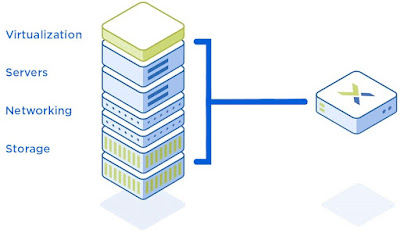Hyperconvergence: Simplifying IT Infrastructure for the Modern Age?
In the world of IT infrastructure, hyper-convergence is a relatively new concept that is rapidly gaining popularity. The term refers to the integration of computing, storage, and networking components into a single, scalable, and easy-to-manage platform. Hyperconvergence is seen as a natural evolution of the converged infrastructure model, which brings together storage, computing, and networking components in a single architecture. However, hyperconvergence takes this one step further by integrating software-defined components that enable more agility and flexibility. In this blog post, we will explore the concept of hyperconvergence, its benefits, and the reasons behind its growing popularity.
The Hyperconvergence Model
Hyperconvergence is built on the idea of software-defined infrastructure. This means that the computing, storage, and networking components are all managed through a single software layer, rather than separate hardware devices. This software layer provides a level of abstraction that enables organizations to manage their infrastructure in a more agile and flexible manner. In addition, the software-defined components are highly scalable, enabling organizations to easily add more resources as their needs grow.Hyperconverged systems typically consist
of a number of nodes, each of which contains compute, storage, and networking
components. These nodes are connected via high-speed network links to form a
single, highly available and resilient system. The nodes are managed through a
centralized management console that provides a single view of the entire infrastructure.
The Benefits of Hyperconvergence
Hyperconvergence offers a number of
benefits to organizations that adopt it. Here are some of the most significant:
- Simplified
Management: By integrating all the components of the infrastructure into a
single platform, hyperconvergence makes management much simpler. There is
no need to manage separate computing, storage, and networking components,
and the entire infrastructure can be managed through a single interface.
This reduces the complexity of managing the infrastructure and makes it
easier to identify and resolve issues.
- Scalability:
Hyperconverged systems are highly scalable, and can easily be expanded to
meet the needs of growing organizations. New nodes can be added to the
infrastructure without disruption, and the centralized management console
makes it easy to manage the entire infrastructure.
- Reduced
Costs: Hyperconvergence can help reduce costs by simplifying management
and reducing the need for separate hardware components. In addition,
hyperconverged systems are highly efficient and can help organizations
reduce their energy consumption and cooling costs.
- Improved
Performance: Hyperconverged systems can improve performance by providing
faster access to data and resources. This is because the computing, storage,
and networking components are all integrated into a single platform,
reducing latency and enabling faster data transfers.
- Better
Disaster Recovery: Hyperconverged systems are highly resilient, and can
provide better disaster recovery capabilities than traditional
infrastructure models. This is because hyperconverged systems are designed
to be highly available, and can automatically failover in the event of a
hardware failure.
The Popularity of Hyperconvergence
Hyperconvergence is becoming increasingly
popular for a number of reasons. One of the primary reasons is the need for a more agile and flexible infrastructure. Traditional infrastructure models can
be difficult to manage, and may not be able to keep up with the changing needs
of modern organizations. Hyperconverged systems, on the other hand, are
designed to be highly agile and flexible and can be easily adapted to meet
changing business needs.
Another reason for the popularity of
hyperconvergence is the increasing demand for cloud-like infrastructure models.
Cloud computing has become the de facto standard for many organizations, as it
provides a high level of agility and scalability. Hyperconverged systems
provide many of the same benefits as cloud computing but with the added
advantage of being on-premises.
Finally, hyperconvergence is becoming more
popular because of the increasing adoption of virtualization technology
The choice between non-converged and hyperconverged systems depends on the specific needs and requirements of an organization. While non-converged systems may be more flexible and customizable, hyperconverged systems can offer greater simplicity and efficiency.





Comments
Post a Comment